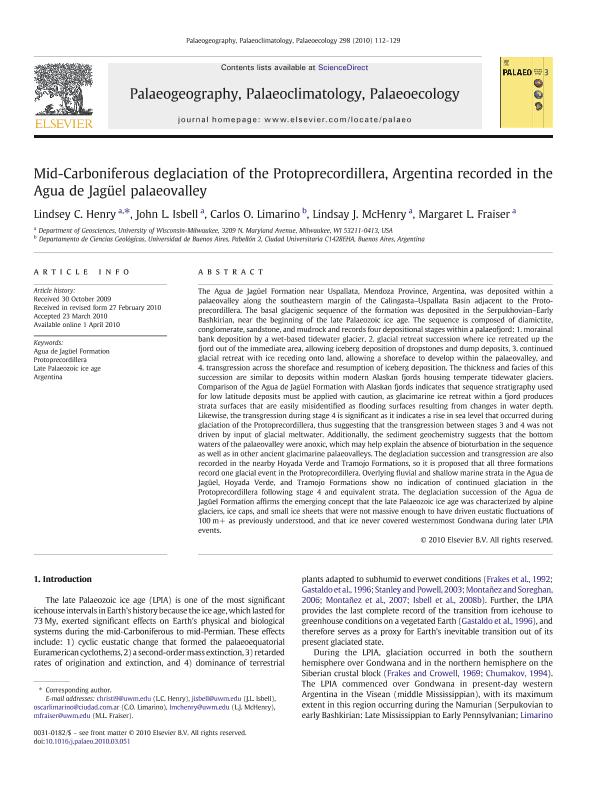Mostrar el registro sencillo del ítem
dc.contributor.author
Henry, Lindsey C.
dc.contributor.author
Isbell, John L.
dc.contributor.author
Limarino, Carlos Oscar

dc.contributor.author
McHenry, Lindsay J.
dc.contributor.author
Fraiser, Margaret L.
dc.date.available
2019-01-28T17:58:55Z
dc.date.issued
2010-12
dc.identifier.citation
Henry, Lindsey C.; Isbell, John L.; Limarino, Carlos Oscar; McHenry, Lindsay J.; Fraiser, Margaret L.; Mid-Carboniferous deglaciation of the Protoprecordillera, Argentina recorded in the Agua de Jagüel palaeovalley; Elsevier Science; Palaeogeography, Palaeoclimatology, Palaeoecology; 298; 1-2; 12-2010; 112-129
dc.identifier.issn
0031-0182
dc.identifier.uri
http://hdl.handle.net/11336/68754
dc.description.abstract
The Agua de Jagüel Formation near Uspallata, Mendoza Province, Argentina, was deposited within a palaeovalley along the southeastern margin of the Calingasta-Uspallata Basin adjacent to the Protoprecordillera. The basal glacigenic sequence of the formation was deposited in the Serpukhovian-Early Bashkirian, near the beginning of the late Palaeozoic ice age. The sequence is composed of diamictite, conglomerate, sandstone, and mudrock and records four depositional stages within a palaeofjord: 1 morainal bank deposition by a wet-based tidewater glacier, 2 glacial retreat succession where ice retreated up the fjord out of the immediate area, allowing iceberg deposition of dropstones and dump deposits, 3 continued glacial retreat with ice receding onto land, allowing a shoreface to develop within the palaeovalley, and 4 transgression across the shoreface and resumption of iceberg deposition. The thickness and facies of this succession are similar to deposits within modern Alaskan fjords housing temperate tidewater glaciers. Comparison of the Agua de Jagüel Formation with Alaskan fjords indicates that sequence stratigraphy used for low latitude deposits must be applied with caution, as glacimarine ice retreat within a fjord produces strata surfaces that are easily misidentified as flooding surfaces resulting from changes in water depth. Likewise, the transgression during stage 4 is significant as it indicates a rise in sea level that occurred during glaciation of the Protoprecordillera, thus suggesting that the transgression between stages 3 and 4 was not driven by input of glacial meltwater. Additionally, the sediment geochemistry suggests that the bottom waters of the palaeovalley were anoxic, which may help explain the absence of bioturbation in the sequence as well as in other ancient glacimarine palaeovalleys. The deglaciation succession and transgression are also recorded in the nearby Hoyada Verde and Tramojo Formations, so it is proposed that all three formations record one glacial event in the Protoprecordillera. Overlying fluvial and shallow marine strata in the Agua de Jagüel, Hoyada Verde, and Tramojo Formations show no indication of continued glaciation in the Protoprecordillera following stage 4 and equivalent strata. The deglaciation succession of the Agua de Jagüel Formation affirms the emerging concept that the late Palaeozoic ice age was characterized by alpine glaciers, ice caps, and small ice sheets that were not massive enough to have driven eustatic fluctuations of 100 m+ as previously understood, and that ice never covered westernmost Gondwana during later LPIA events.
dc.format
application/pdf
dc.language.iso
eng
dc.publisher
Elsevier Science

dc.rights
info:eu-repo/semantics/openAccess
dc.rights.uri
https://creativecommons.org/licenses/by-nc-nd/2.5/ar/
dc.subject
Agua de JagÜEl Formation
dc.subject
Argentina
dc.subject
Late Palaeozoic Ice Age
dc.subject
Protoprecordillera
dc.subject.classification
Paleontología

dc.subject.classification
Ciencias de la Tierra y relacionadas con el Medio Ambiente

dc.subject.classification
CIENCIAS NATURALES Y EXACTAS

dc.title
Mid-Carboniferous deglaciation of the Protoprecordillera, Argentina recorded in the Agua de Jagüel palaeovalley
dc.type
info:eu-repo/semantics/article
dc.type
info:ar-repo/semantics/artículo
dc.type
info:eu-repo/semantics/publishedVersion
dc.date.updated
2019-01-28T14:03:53Z
dc.journal.volume
298
dc.journal.number
1-2
dc.journal.pagination
112-129
dc.journal.pais
Países Bajos

dc.journal.ciudad
Amsterdam
dc.description.fil
Fil: Henry, Lindsey C.. University of Wisconsin; Estados Unidos
dc.description.fil
Fil: Isbell, John L.. University of Wisconsin; Estados Unidos
dc.description.fil
Fil: Limarino, Carlos Oscar. Consejo Nacional de Investigaciones Científicas y Técnicas. Oficina de Coordinación Administrativa Ciudad Universitaria. Instituto de Geociencias Básicas, Aplicadas y Ambientales de Buenos Aires. Universidad de Buenos Aires. Facultad de Ciencias Exactas y Naturales. Instituto de Geociencias Básicas, Aplicadas y Ambientales de Buenos Aires; Argentina
dc.description.fil
Fil: McHenry, Lindsay J.. University of Wisconsin; Estados Unidos
dc.description.fil
Fil: Fraiser, Margaret L.. University of Wisconsin; Estados Unidos
dc.journal.title
Palaeogeography, Palaeoclimatology, Palaeoecology

dc.relation.alternativeid
info:eu-repo/semantics/altIdentifier/doi/http://dx.doi.org/10.1016/j.palaeo.2010.03.051
dc.relation.alternativeid
info:eu-repo/semantics/altIdentifier/url/https://www.sciencedirect.com/science/article/pii/S0031018210001902
Archivos asociados
